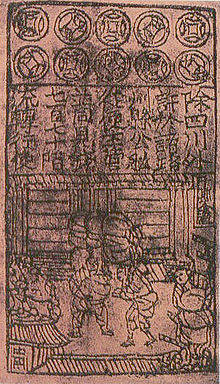loading...



From Wikipedia, the free encyclopedia
A currency (from Middle English: curraunt, “in circulation”, from Latin: currens, -entis) in the most specific use of the word refers to money in any form when in actual use or circulation as a medium of exchange, especially circulating banknotes and coins.[1][2] A more general definition is that a currency is a system of money (monetary units) in common use, especially in a nation.[3] Under this definition, US dollars, British pounds, Australian dollars, and European euros are examples of currency. These various currencies are recognized stores of value and are traded between nations in foreign exchange markets, which determine the relative values of the different currencies.[4] Currencies in this sense are defined by governments, and each type has limited boundaries of acceptance.
Other definitions of the term “currency” are discussed in their respective synonymous articles banknote, coin, and money. The latter definition, pertaining to the currency systems of nations, is the topic of this article. Currencies can be classified into two monetary systems: fiat money and commodity money, depending on what guarantees the value (the economy at large vs. the government’s physical metal reserves). Some currencies are legal tender in certain political jurisdictions, which means they cannot be refused as payment for debt. Others are simply traded for their economic value. Digital currency has arisen with the popularity of computers and the Internet.
Contents
[hide]
History[edit]
Early currency[edit]
Currency evolved from two basic innovations, both of which had occurred by 2000 BC. Originally money was a form of receipt, representing grain stored in temple granaries in Sumerin ancient Mesopotamia, then Ancient Egypt.
In this first stage of currency, metals were used as symbols to represent value stored in the form of commodities. This formed the basis of trade in the Fertile Crescent for over 1500 years. However, the collapse of the Near Eastern trading systempointed to a flaw: in an era where there was no place that was safe to store value, the value of a circulating medium could only be as sound as the forces that defended that store. Trade could only reach as far as the credibility of that military. By the late Bronze Age, however, a series of treatieshad established safe passage for merchants around the Eastern Mediterranean, spreading from Minoan Crete and Mycenae in the northwest to Elam and Bahrain in the southeast. It is not known what was used as a currency for these exchanges, but it is thought that ox-hide shaped ingots of copper, produced in Cyprus, may have functioned as a currency.
It is thought that the increase in piracy and raiding associated with the Bronze Age collapse, possibly produced by the Peoples of the Sea, brought the trading system of oxhide ingots to an end. It was only with the recovery of Phoenician trade in the 10th and 9th centuries BC that saw a return to prosperity, and the appearance of real coinage, possibly first in Anatolia with Croesus of Lydia and subsequently with the Greeks and Persians. In Africa, many forms of value store have been used, including beads, ingots, ivory, various forms of weapons, livestock, the manilla currency, and ochre and other earth oxides. The manilla rings of West Africa were one of the currencies used from the 15th century onwards to sell slaves. African currency is still notable for its variety, and in many places various forms of barter still apply.
Coinage[edit]
These factors led to the metal itself being the store of value: first silver, then both silver and gold, and at one point also bronze. Now we have copper coins and other non-precious metals as coins. Metals were mined, weighed, and stamped into coins. This was to assure the individual taking the coin that he was getting a certain known weight of precious metal. Coins could be counterfeited, but they also created a new unit of account, which helped lead to banking. Archimedes’ principleprovided the next link: coins could now be easily tested for their fine weight of metal, and thus the value of a coin could be determined, even if it had been shaved, debased or otherwise tampered with (see Numismatics).
Most major economies using coinage had three tiers of coins: copper, silver and gold. Gold coins were used for large purchases, payment of the military and backing of state activities. Silver coins were used for midsized transactions, and as a unit of account for taxes, dues, contracts and fealty, while copper coins were used for everyday transactions. This system had been used in ancient India since the time of the Mahajanapadas. In Europe, this system worked through the medieval period because there was virtually no new gold, silver or copper introduced through mining or conquest.[citation needed] Thus the overall ratios of the three coinages remained roughly equivalent.
Paper money[edit]
In premodern China, the need for credit and for a medium of exchange that was less physically cumbersome than large numbers of copper coins led to the introduction of paper money, i.e. banknotes. Their introduction was a gradual process which lasted from the late Tang dynasty (618–907) into the Song dynasty (960–1279). It began as a means for merchants to exchange heavy coinage for receipts of deposit issued as promissory notes by wholesalers‘ shops. These notes were valid for temporary use in a small regional territory. In the 10th century, the Song dynasty government began to circulate these notes amongst the traders in its monopolized salt industry. The Song government granted several shops the right to issue banknotes, and in the early 12th century the government finally took over these shops to produce state-issued currency. Yet the banknotes issued were still only locally and temporarily valid: it was not until the mid 13th century that a standard and uniform government issue of paper money became an acceptable nationwide currency. The already widespread methods of woodblock printing and then Pi Sheng‘s movable type printing by the 11th century were the impetus for the mass production of paper money in premodern China.
At around the same time in the medieval Islamic world, a vigorous monetary economy was created during the 7th–12th centuries on the basis of the expanding levels of circulation of a stable high-value currency (the dinar). Innovations introduced by Muslim economists, traders and merchants include the earliest uses of credit,[5]cheques, promissory notes,[6]savings accounts, transactional accounts, loaning, trusts, exchange rates, the transfer of credit and debt,[7] and banking institutions for loans and deposits.[7]
In Europe, paper money was first introduced on a regular basis in Sweden in 1661 (although Washington Irving records an earlier emergency use of it, by the Spanish in a siege during the Conquest of Granada). As Sweden was rich in copper, its low value necessitated extraordinarily big coins, often weighing several kilograms.
The advantages of paper currency were numerous: it reduced the need to transport gold and silver, which was risky; it facilitated loans of gold or silver at interest, since the underlying specie (gold or silver) never left the possession of the lender until someone else redeemed the note; and it allowed a division of currency into credit and specie backed forms. It enabled the sale of stock in joint-stock companies, and the redemption of those shares in paper.
But there were also disadvantages. First, since a note has no intrinsic value, there was nothing to stop issuing authorities from printing more notes than they had specie to back them with. Second, because it increased the money supply, it increased inflationary pressures, a fact observed by David Hume in the 18th century. Thus paper money would often lead to an inflationary bubble, which could collapse if people began demanding hard money, causing the demand for paper notes to fall to zero. The printing of paper money was also associated with wars, and financing of wars, and therefore regarded as part of maintaining a standing army. For these reasons, paper currency was held in suspicion and hostility in Europe and America. It was also addictive, since the speculative profits of trade and capital creation were quite large. Major nations established mintsto print money and mint coins, and branches of their treasury to collect taxes and hold gold and silver stock.
At that time, both silver and gold were considered legal tender, and accepted by governments for taxes. However, the instability in the ratio between the two grew over the course of the 19th century, with the increases both in supply of these metals, particularly silver, and in trade. The parallel use of both metals is called bimetallism, and the attempt to create a bimetallic standard where both gold and silver backed currency remained in circulation occupied the efforts of inflationists. Governments at this point could use currency as an instrument of policy, printing paper currency such as the United States Greenback, to pay for military expenditures. They could also set the terms at which they would redeem notes for specie, by limiting the amount of purchase, or the minimum amount that could be redeemed.
By 1900, most of the industrializing nations were on some form of gold standard, with paper notes and silver coins constituting the circulating medium. Private banksand governments across the world followed Gresham’s Law: keeping the gold and silver they received, but paying out in notes. This did not happen all around the world at the same time, but occurred sporadically, generally in times of war or financial crisis, beginning in the early part of the 20th century and continuing across the world until the late 20th century, when the regime of floating fiat currencies came into force. One of the last countries to break away from the gold standard was the United States in 1971. No country has an enforceable gold standard or silver standard currency system.
Banknote era[edit]
A banknote (more commonly known as a bill in the United States and Canada) is a type of currency, and commonly used as legal tender in many jurisdictions. With coins, banknotes make up the cash form of all money. Banknotes are mostly paper, but Australia’s Commonwealth Scientific and Industrial Research Organisationdeveloped the world’s first polymer currency in the 1980s that went into circulation on the nation’s bicentenary in 1988. Now used in some 22 countries (over 40 if counting commemorative issues), polymer currencydramatically improves the life span of banknotes and prevents counterfeiting.
loading...




0 Response to "“Dia Tak Fikir Ke Sebelum Buat Benda Tu? Saya Tak Sangka Dia Sanggup Buat Benda Tu Pada Saya.. Melampau.!”,Nabil Kena Sembur Direct! Lihat Apa Yang Dia Buat Pada Elly Mazlien Menangis Janda Ni.."
Post a Comment